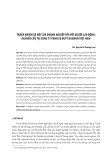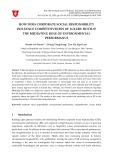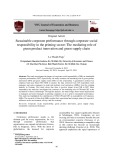
* Corresponding author
E-mail address: kittisak.j@chula.ac.th (K. Jermsittiparsert)
© 2019 by the authors; licensee Growing Science.
doi: 10.5267/j.uscm.2019.1.005
Uncertain Supply Chain Management 7 (2019) 741–752
Contents lists available at GrowingScience
Uncertain Supply Chain Management
homepage: www.GrowingScience.com/uscm
Do consumers expect companies to be socially responsible? The impact of corporate social
responsibility on buying behavior
Kitisak Jermsittiparserta*, Mohammed R A Siamb, Mustafa Rashid Issac, Umair Ahmedd and
Munwar Hussain Pahie
aSocial Research Institute, Chulalongkorn University, Thailand
bSchool of business management SBM, University Utara Malaysia UUM, Malaysia
cDepartment of Law, Ishik University Iraq, Iraq
dArab Open University Bahrain, Bahrain
eMunwar Hussain pahi, Indus Industry university Karachi, Pakistan
C H R O N I C L E A B S T R A C T
Article history:
Received December 5, 2018
Received in revised format
January 21, 2019
Accepted January 31 2019
Available online
January 31 2019
Corporate social responsibility (CSR) is one of the important factors to increase the customer
satisfaction. It is part of the economic, legal and moral exercises of a business element guided
towards enhancing the business and societal desires. However, companies are facing various
issues while adopting CSR practices, particularly Indonesian logistics companies. Challenges
in the way of CSR practices affect adversely on customer satisfaction. Therefore, the objective
of the present study is to highlight the role of CSR in customer satisfaction among Indonesian
logistics firms. In this study, opinions of logistics customers were gathered through survey
questionnaires. All the responses were analyzed through structural equation modeling
technique. The findings of the study suggest that logistics companies should focus on two CSR
practices, 1) environmental contribution and, 2) human resources. Environmental contribution
and human resource promote community development which lead towards higher customer
satisfaction.
., Canada
by
the authors; licensee Growin
g
Science2019 ©
Keywords:
CSR
Logistic customer satisfaction
Environmental contribution
Human resources
1. Introduction
The major objective of every organization is the delivery of value to their stakeholders (Dembek et al.,
2018; Mendes & Dias, 2018). Profit-oriented companies are not charitable companies, even though
their interests are occasionally directed towards subsidizing charitable practices. From time to time, it
is useful for companies to focus on charitable practices that should be commenced by government,
however they are not government interventions. These charitable practices are viewed as corporate
social responsibilities (CSR) (Mohamed & Sawandi, 2007;Chidoko & Mashavira, 2014; Salvioni &
Gennari, 2014; Razek, 2014; Eshiet, 2017; Mejdoub & Arab, 2017; Oitsile et al., 2018; Chang’ach,
2018). CSR is a part of the economic, legal and moral exercises of a business element guided towards
enhancing the business and societal desires (Joyner et al., 2002). Richardson et al. (1999) viewed CSR
as a progressing emphasis and commitment of corporate organization to the moral components of their






























